Brian Meert's Blog, page 132
January 18, 2018
How to Control What Visitors Post on Your Facebook Page
 January 18, 2018
January 18, 2018Anna Hubbel

As transparent and engaging as you may want your Facebook page to be, nobody likes a troll. The best way to prevent users from trolling your page is by preventing visitors from posting on your page, which you can do by changing your settings.
Prevent #trolls from trolling your @Facebook page by changing your settings. #facebookhowto
Click To Tweet
Steps for Changing Visitor Page Settings
Step 1: After logging into your page, go to “Settings” at the top right of the page.
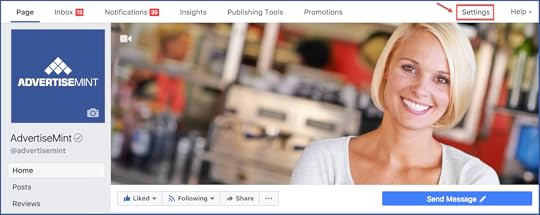
Step 2: With the “General” tab selected, find and select “Visitor Posts.”

Step 3: You then have the option to select either “Allow visitors to the Page to publish posts” or “Disable posts by other people on the Page” (depending on your preference).

If you’ve selected “Allow visitors to the Page to publish posts,” you have two options to choose from: “Allow photo and video posts” or “Review posts by other people before they’re published to the Page.”
If you select to review posts, you are able to review posts first by going to “Posts by Others” in your activity log. By approving a post upon review, you can then choose to allow it on your page.
Step 5: After you’ve specified your preferences, select “Save Changes.”

Additionally, when it comes to visitors’ posts, you can also:
Hide or delete individual comments
Block words and turn on the profanity filter
Ban specified users from your page
Turn off reviews for your page
If you want to change more of your page settings, you can also learn how to turn off similar page suggestions on your Facebook page.
The post How to Control What Visitors Post on Your Facebook Page appeared first on AdvertiseMint.
January 17, 2018
10 Percent of Total US Ad Spending in 2018 Predicted to Go to Facebook
 January 17, 2018
January 17, 2018Anna Hubbel

The year 2018 is looking exciting for social media, eMarketer is predicting. Both Facebook and Snapchat are expected to see ad revenue growth (especially Facebook), and it’s unlikely that we’ll see any less of either social media company in the headlines around political ad transparency.
10% of total US ad spending in 2018 predicted to go to @Facebook . #futureofsocialmedia #emarketerforecasts #emarketer
Click To Tweet
Ad Revenue Growth
As predicted by eMarketer, Facebook will take $1 of every $10 spent on both digital and non-digital advertising in 2018. Additionally, the powerhouse social media company is expected to reach $21.57 billion in US ad revenues this year. That’s double what will be spent on newspaper advertising and almost as much as print advertising spends in entirety (which will total about $23.12 billion).
To top it off, that 10 percent Facebook will account for this year will bump up to 11.3 percent in 2019, eMarketer forecasts.
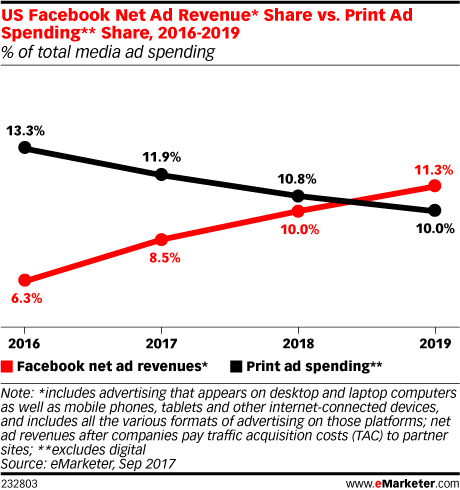 Photo Courtesy of eMarketer
Photo Courtesy of eMarketerSnapchat, meanwhile, is expected to generate $1.18 billion in US ad revenues this year. Considering Snapchat’s failure to meet desired revenues early last year, this number is promising and likely comes from Snap’s new conversion into a more advertising-friendly platform. For example, in May 2017, Snapchat rolled out its self-serve ad manager, and in the summer, released advanced mode for Ad Manager. Additionally, the network recently introduced Context Cards, which provide users with basic information about local businesses.
Ad Transparency
Facebook has made national headlines as of late in regards to political ad transparency. A majority of the scrutiny has come from the recent discovery of politically divisive ads originating from Russian troll accounts who distributed the fake news across Facebook during the 2016 US presidential election. Since then, Facebook has been the center focus of ad transparency issues.
In light of these and similar events, Facebook has taken full-throttle, zero-tolerance actions to increase transparency and safer experiences across the platform. For instance, the network placed a temporary block on ads excluding ethnic and racial groups and removed self-reported targeting to prevent discrimination. Additionally, Facebook CEO Mark Zuckerberg made a 2018 resolution to fix Facebook’s mistakes.
Zuckerberg also just recently announced a major change to News Feed, which will decrease the amount of businesses’ content on the feed to promote more meaningful interactions between friends and family.
The post 10 Percent of Total US Ad Spending in 2018 Predicted to Go to Facebook appeared first on AdvertiseMint.
January 16, 2018
How to Turn Off Similar Page Suggestions on Your Facebook Page
 January 17, 2018
January 17, 2018Anna Hubbel
 Photo Courtesy of TechCrunch
Photo Courtesy of TechCrunchWhen users visit your Facebook page, you want them to have your page at the forefront of their minds. You may prefer that they don’t see suggestions for pages similar to yours while they are visiting your page. These suggestions typically appear in the People Also Like section of your page, on the right-hand side. Conveniently, there’s a way to turn off these page recommendations. Note that only page admins can turn off page suggestions.
Turn off page suggestions for your @Facebook page in 4 easy steps. #facebookhacks
Click To Tweet
Step 1: Go to “Settings” at the top right of your Page.
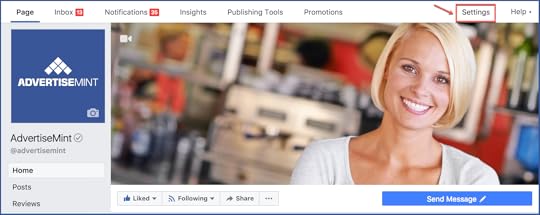
Step 2: With the “General” tab selected at the left, select to edit “Similar Page Suggestions.” 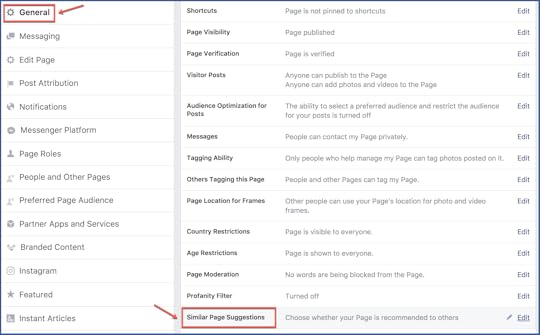
Step 3: When the option to include your page when recommending similar pages appears, click the box next to it to check or uncheck it.

Step 4: Save your changes.

It should also be noted that by turning off page suggestions, you also stop your page from appearing in the People Also Like section of other businesses’ Facebook pages.
The post How to Turn Off Similar Page Suggestions on Your Facebook Page appeared first on AdvertiseMint.
January 6, 2018
Effective Mobile Video Techniques According to Facebook Study
 January 6, 2018
January 6, 2018Anna Hubbel

A recent Facebook-commissioned study revealed common themes in effective mobile video techniques, primarily the use of brand type and brand placement. Using 759 video ads from more than 300 brands, the study surveyed viewers’ responses regarding brand recall, the viewers’ ability to remember the brand in the video they saw.
A recent @Facebook study revealed common themes in effective #mobilevideo techniques, primarily the use of #brandtype & #brandplacement.
Click To Tweet
Video ads created for mobile first, the study revealed, performed the best. “Mobile first” simply means the videos were created specifically for mobile, using shorter duration times and displaying the brand within the first few seconds. In contrast, videos adapted to mobile, displaying the brand early in a long video, and traditional narratives, displaying the brand later in the video, did not perform as well in brand recall.
According to Social Media Today, clearly identifying brand early on helps solidify the message, as well as show credibility and relevance. Additionally, establishing the brand in the first few seconds of the video was crucial in improving aided recall, giving users cues to help them remember the brand.
 Photo Courtesy of SocialMediaToday
Photo Courtesy of SocialMediaTodayAs previously mentioned, brand type was another theme uncovered in the study. Differing types include a smaller presence, such as adding the brand as a watermark, or a stronger presence, such as placing the brand front and center. Facebook found that stronger brand types performed high in aided recall as opposed to those with a weak presence. It’s also worth noting that shorter videos, as in mobile first ads, unsurprisingly performed better than videos with longer durations.
The post Effective Mobile Video Techniques According to Facebook Study appeared first on AdvertiseMint.
January 4, 2018
12 Tweets That Will Get Your Twitter Account Suspended
 January 5, 2018
January 5, 2018Anna Hubbel

Twitter is an illustrious social platform for distributing quick snippets of information and connecting with the world. To maintain continued use of Twitter, accounts must adhere to its strict rules that outline specific account activity that could result in suspension. Here are 12 tweets that could result in Twitter suspending an account.
To maintain continued use of @Twitter , accounts must adhere to the strict #TwitterRules , which outline specific account activity that could result in account suspension. #socialpolicies
Click To Tweet
1. Tweets That Aren’t Clear About Brand Affiliation
Accounts want to avoid tweeting content that uses a brand or trademark in a way that does not clearly and accurately communicate brand affiliation.
2. Tweets That Contain Copyright Infringement
Twitter’s Terms of Service outline strict copyright procedures, prohibiting users from infringing upon others’ creative and intellectual property.
3. Tweets That Contain Excessively Graphic Violence or Adult Content
Although Twitter allows some forms of graphic violence and adult content, it discourages excessive use of it. Typically, Twitter will request that you remove tweets it considers inappropriate. However, if you do not respectfully do as they request, your account may be suspended.
4. Tweets That Violate Lawful Use
It goes without saying that tweets should not engage in any unlawful activity.
5. Tweets That Contain Trending Content That Violates Its Rules
Trending content that is in violation of Twitter’s rules is subject to removal. See Twitter trends FAQ for more specific information.
6. Tweets That Use Unauthorized Twitter Badges
Only badges provided by Twitter are allowed to be used by an account. Otherwise, the account is falsely implying affiliation with Twitter.
7. Tweets That Misuse Twitter Usernames
Accounts may not sell Twitter usernames. Additionally, Twitter prohibits username squatting, creating multiple accounts for unfair use, such as preventing others’ use of certain usernames.
8. Tweets That Are Abusive or Threatening
Tweets that target an individual or group of people in a manner that is abusive, hateful, harassing, threatening, or intimidating violate Twitter’s policies. Threatening tweets include promoting physical harm to others or to oneself. Unwanted sexual advances are also prohibited.
9. Tweets That Contain Child Sexual Exploitation
Twitter has zero tolerance for accounts that use its platform to sexually exploit children. See Twitter’s child sexual exploitation policy for more information.
10. Tweets That Contain Private Information or Intimate Media
Unless user consent is given, tweets are prohibited from sharing private information and intimate photos or videos.
11. Tweets That Impersonate Others
Impersonation of other individuals, groups, or organizations is a form of deception, which violates Twitter’s policies. Even parodies and commentaries are subject to scrutiny if they engage in spam or abusive behavior.
12. Tweets That Contain Spam or Threaten Security
Twitter may lock or permanently suspend accounts that distribute content containing any form of spam or malware, use the platform to tamper with computer systems, deceive other users, or interfere with other users’ access in any way. See the Spam and Security section of The Twitter Rules for the full list of prohibited behaviors in this category.
Learn how to give access to your Twitter ads account.
The post 12 Tweets That Will Get Your Twitter Account Suspended appeared first on AdvertiseMint.
6 Actionable Tips for Facebook Advertising Beginners
 January 5, 2018
January 5, 2018Anna Hubbel

You’ve probably seen a plethora of blog posts about Facebook advertising. They tell you about all the nitty-gritty aspects, discuss the high-tech tools available, and praise the successes of doing it right. But you’re just starting out and want to know exactly what it is you can do right now. Here are six actionable tips to get you started as a beginner in Facebook advertising.
6 actionable tips for @Facebook #advertisingbeginners. #getstarted #facebookadvertising
Click To Tweet
1. Create a Relevant Facebook Page for Your Business
First things first: create a Facebook page for your business. Give it a professional profile picture (such as your business logo), fill out the About section in full, upload photos of your products and employees, and give it a relevant username. In order to reap the benefits of Facebook advertising tools, such as Business Manager and Audience Network, you need to get your business seen on the network. It’s the best way to get exposure for your business.
2. Do Your Research
Jumping right in with a learn-as-you-go approach is a guaranteed way to waste time and money. There is a limitless number of Facebook advertising resources available. Take advantage of those resources and educate yourself on all the different aspects of Facebook advertising, such as targeting, ad formats, policies, management tools, and analytics.
3. Choose the Right Objective for Your Campaign
Facebook’s ad objectives allow you to build a campaign that delivers results for your goal. Determine what you want your campaign to do. Do you want to garner visits to your website, encourage users to share their contact information, or drive visits to your brick-and-mortar store? Choosing the wrong objective will result in campaign failure. If you don’t know the objectives you have available to you, see Facebook’s list of advertising objectives.
4. Define Your Audience
First, you want to easily describe the audience you want to target with your Facebook ads. For example, if you own a fashion retail store, your target audience should include fashionistas or teenage girls, to name a few. Once you describe your audience demographic, you can look at Facebook’s Custom Audience options, which will help drive desired outcomes based on your defined audience.
5. Study Your Competition
See what other businesses in your niche are doing in Facebook advertising. Take note of what works for them, what stands out, what you like, or what you don’t like. Getting inspiration and information from your competition will help you craft your own unique campaign.
6. Work with an Advertising Team
The best way to guarantee success in your Facebook advertising endeavors is to work with a professional and experienced advertising team. It ensures that you’re putting out high-quality ads from the get-go, generated with top-notch creativity and intellect.
To learn more about all the different elements and strategies involved in advertising with Facebook, check out The Complete Guide to Facebook Advertising.
The post 6 Actionable Tips for Facebook Advertising Beginners appeared first on AdvertiseMint.
Mark Zuckerberg Shares His 2018 Resolution: Fixing Facebook
 January 4, 2018
January 4, 2018Anne Felicitas
#Facebook 's CEO #MarkZuckerberg outlines his personal challenge this year: fix Facebook.
Click To Tweet Photo courtesy of Facebook Newsroom
Photo courtesy of Facebook Newsroom
Facebook’s 2017 was filled with blunders. In a year, Facebook faced the scandals of fake news, exploitation of its ad targeting features, fake Russian ads, pages, and user accounts, and hate speech. As Facebook enters the new year, its CEO, Mark Zuckerberg, announces his 2018 resolution: repair Facebook’s mistakes.
In a message posted on his personal Facebook account, Zuckerberg vows to spend the next year fixing abuse on its platform, preventing foreign interference, and exploring technology that will place power in the people.
“Every year I take on a personal challenge to learn something new,” began the post. “I’ve visited every US state, run 365 miles, built an AI for my home, read 25 books, and learned Mandarin.”
This year, Zuckerberg’s resolution is less personal and more work related.
“The word feels anxious and divided, and Facebook has a lot of work to do, whether it’s protecting our community from abuse and hate, defending against interference by nation states, or making sure that time spent on Facebook is time well spent. My personal challenge for 2018 is to focus on fixing these important issues.”
In fixing these issues, Zuckerberg is acquiring the help of experts knowledgeable in these topics.
“These issues touch on questions of history, civics, political philosophy, media, government, and of course technology. I’m looking forward to bringing groups of experts together to discuss and help work through these topics.”
Although Zuckerberg does not reveal the identities of those experts, an announcement on the company’s press page will likely arrive in the coming months.
In addition to making its platform a safer place, Zuckerberg also vows to explore technologies that shift the power from governments to citizens.
“There are important counter trends to this [the centralization of power] like encryption and cryptocurrency that take power from centralized systems and put it back into people’s hands. I’m interested to go deeper and study the positive and negative aspects of these technologies.”
Zuckerberg’s 2018 resolution may be his biggest yet. It is now up to the public to ensure he remains true to his word.
The post Mark Zuckerberg Shares His 2018 Resolution: Fixing Facebook appeared first on AdvertiseMint.
January 3, 2018
6 eMarketer Facts to Know About Users’ Time Spent With Media
 January 4, 2017
January 4, 2017Anna Hubbel

It’s no secret: as modern consumers, we spend an excessive amount of time with media. However, as eMarketer discovered, how we spend our time with media may not be as black and white as we may think. Here are six facts eMarketer discovered about time US adult users spend with media.
@eMarketer discovered 6 facts about how users spend their time with media. #mediaconsumption #knowledgeispower #funfacts
Click To Tweet
1. US Adult Users Spend More Time Listening to the Radio Than Using Social Networks
Although you don’t hear much about radio these days, we obviously listen to it more than we realize. According to eMarketer, adult users in the US spent an average of 1 hour, 26 minutes listening to the radio in 2017. In contrast, average use of social media in 2017 came to 40 minutes on mobile, 11 minutes on computers.
2. When It Comes to Media Consumption, We’re Actually in a State of Gradual Change
It may seem like we are rapidly and ferociously increasing our time spent on media. However, eMarketer says the hype has actually died down and that unless the next big thing comes out sometime soon, we can expect consumption to grow at only 3.5 percent.
3. Time Spent on Facebook Continues to Increase in Spite of Competition
Even as networks like Snapchat keep growing and rolling out new features, we will increase our daily time spent on Facebook by one minute each year between now and 2019. In 2017, eMarketer says average time spent on the social network was 25 minutes, meaning time is expected to increase to 26 minutes in 2018.
4. Adult Users Spend One-Third of Their Smartphone-Plus-Tablet Non-voice Time on Tablets
We spent an average of 1 hour, 12 minutes on tablets in 2017, according to eMarketer. Compare that to the 2 hours, 3 minutes spent on smartphones, and you see that users still spend a good bit of time on tablet devices.
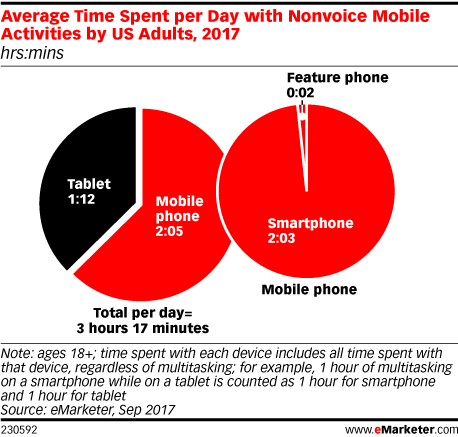 Photo Courtesy of eMarketer
Photo Courtesy of eMarketer5. Average Time Spent Watching Non-digital TV Is over Two Hours Higher Than Digital Video
Although we are spending less and less time watching traditional TV than before, we’re still watching it. A daily average of 3 hours, 58 minutes was estimated for 2017. Comparatively, only 1 hour, 17 minutes was estimated for digital video. That gap, says eMarketer, will shrink by 2019, as the numbers continue to shift in favor of digital. However, that doesn’t mean we won’t still be spending a good bit of our media time watching traditional TV.
6. Ad Dollars Spent on Non-voice Mobile Is Higher Than Time Spent on Non-voice Mobile
As advertisers, we may be jumping the gun a bit, investing a lot of money on ads for mobile devices to the point where it outweighs the time users are actually spending on their devices. According to eMarketer, mobile’s share of ad outlays was 30.2 percent in 2017, but only 28.1 percent of users’ time was spent on their mobile devices.
As useful as this knowledge of current media consumption trends is to us as advertisers, it’s also important to note that these trends can change dramatically as new technology products emerge. In the meantime, let’s use the information we have to craft strategies that match these current trends, and then we can adapt as necessary.
Read about the seven popular topics and trends on Facebook in 2017.
The post 6 eMarketer Facts to Know About Users’ Time Spent With Media appeared first on AdvertiseMint.
2017 Findings: 7 Popular Topics and Trends on Facebook
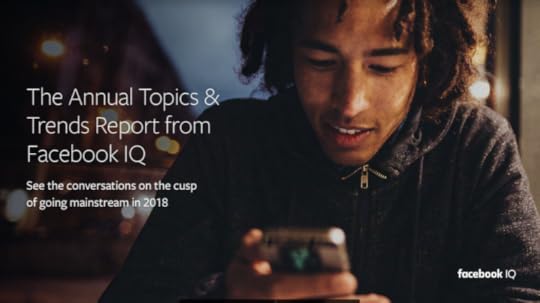 January 3, 2018
January 3, 2018Anna Hubbel
 Photo Courtesy of Facebook IQ
Photo Courtesy of Facebook IQThe year 2017 is a wrap, and to help advertisers go into 2018 with knowledge of what is likely to be popular, Facebook IQ compiled data on rising topics and trends across the platform. Specifically, seven categories emerged in their 2017 findings: beauty and fashion, commerce, culture, entertainment, food and drink, mind and body, and technology.
@Facebook IQ compiled data on rising topics & trends. 7 categories emerged: #Beauty&Fashion, #Commerce, #Culture, #Entertainment, #Food&Drink, #Mind&Body, & #Technology.
Click To Tweet
1. Beauty and Fashion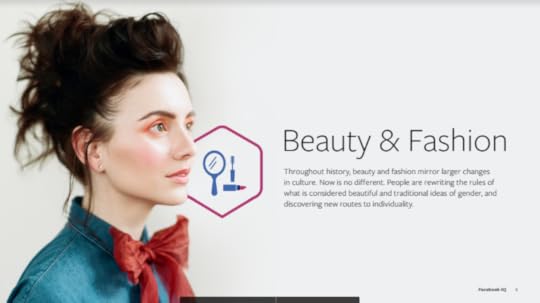 Photo Courtesy of Facebook IQ
Photo Courtesy of Facebook IQ
Beauty and Taboo Topics—Once-taboo topics are now discussed at length on Facebook, such as hair removal and body image. There is more transparency, with models and celebrities sharing photos of themselves pre-photoshop. Beauty buyers are more open to sharing their authentic selves and the lengths they go to achieve their ideal beauty.
Uniform Not Wanted—Rather than having one style of the times, users are inspired by the diverse styles of social media users across the globe, not just major influencers. Facebook found that popular terms to describe jeans on Instagram, for instance, include “bell bottoms,” “capris,” and “mom jeans.” These terms are diverse and a far cry from the typical skinny jeans that were once the dominating style according to fashionistas. Now everyone who considers themselves a fashion expert can inspire style, and bell bottoms are among jean styles discussed the most.
Women and Men’s Wear—”Androgyny,” “boyfriend fashion,” and “unisex” are among the popular terms used online when discussing clothing. Traditional dress prejudice is becoming less and less of a concern as the world becomes more accepting of men who like to wear skirts and women who choose to dress more masculine.
2. Commerce
 Photo Courtesy of Facebook IQ
Photo Courtesy of Facebook IQChoice Simplified—Businesses that specialize in a limited number of products or designs have seen great success when they simplify the decision-making process for consumers. For example, one company sold only one model of mattresses in a box and established a thriving business. It found a niche and made it simple, making its business attractive to buyers. Convenience and simplification in today’s commerce are major buying influencers.
Make It About Me—A personalized service or experience delights the average customer, especially when it comes to subscription business models, which use past shopping behaviors and browsing histories to personalize products for each unique consumer.
The Rise of Cryptocurrency—Facebook users have increasingly discussed the concept of digital currency, cryptocurrency, and blockchain. Facebook found that regulation of such currencies is beginning to take shape, meaning users will soon likely see new ways to participate in online commerce.
3. Culture
 Photo Courtesy of Facebook IQ
Photo Courtesy of Facebook IQEmpowerment Marketing—A topic of major popularity on Facebook is empowered women. Images of women in army or firefighter uniforms are likely to sell better than women in their underwear. Today’s culture of gender equality is strongly influencing the online market.
National Day of What?—Whether it’s Friendship Day or International Coffee Day, users are continuously finding new, everyday holidays to celebrate on social media. It’s a way to celebrate the simple pleasures of life, which can make for a great marketing strategy.
West Meets East—Social media connects the East to the United States through holidays such as Singles’ Day and the Chinese New Year. Since users can connect with cultures across the globe, it’s easier to stay in the know about such holidays, making for a more cultured online society.
4. Entertainment
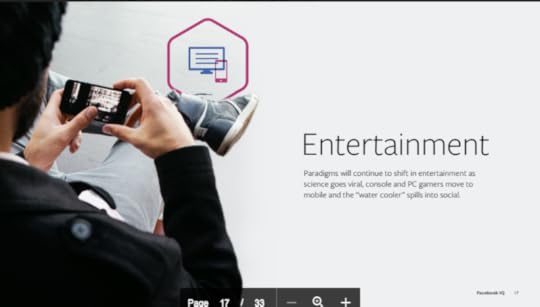 Photo Courtesy of Facebook IQ
Photo Courtesy of Facebook IQGet Your Geek On—That which used to make people snooze during scientific lectures is now the cause of viral videos shared on social media. For example, the American Eclipse was highly discussed on Facebook, with users sharing videos and memes of the cultural experience.
Mid-core Mobile Gamers—A step below hardcore gamers, mid-core gamers, who like the competition and like to nerd out but don’t have time to spend hours playing games, are drawn to mobile game experiences. Popular mobile games like adventure games, multiplayer online games, and role-playing games are among the popular Facebook conversations in 2017.
The New Water Cooler—Similar to coworkers discussing their favorite shows at the office water cooler, users share opinions and discussions about shows on social networks. Stranger Things, for instance, was the focus of many Facebook conversations shortly after the release of its second season in 2017.
5. Food and Drink
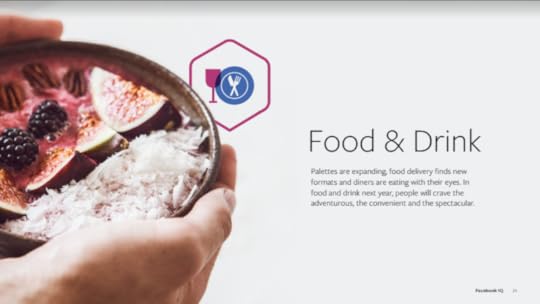 Photo Courtesy of Facebook IQ
Photo Courtesy of Facebook IQAdventures in Eating—With users sharing more and more photos of their eccentric and colorful meals, social networks have become a hub for inspiration when it comes to more adventurous and cultural cuisines. Among the top conversations on Facebook include dishes like adobada and chicken feet.
Convenient Formats—Meal kits and online food ordering are increasing in popularity, as ease and convenience are all the rage. Online food ordering and online grocers have become a more sophisticated form of dining.
Picture-Perfect Food—Facebook says that 69 percent of Millennials take a photo or video of their food to chronicle their experience. Conversations about food photography, milkshakes, and cotton candy have been among the most popular in food and drink.
6. Mind and Body
 Photo Courtesy of Facebook IQ
Photo Courtesy of Facebook IQA New Age for Pain—Holistic approaches to health are now more highly recommended than prescription medication, with acupuncture, myotherapy, and reiki, a Japanese stress-reducing technique, taking a major focus in online conversations.
Industry of Calm—More attention is being given to stress as the world becomes more attentive to mental health. Chakra, introspection, and meditation are dominant online conversation topics.
Personality at Work—Personality and the role it plays in building effective workforce teams among Millennials is more of a priority now that it ever has been. Leading online conversations on the topic have revolved around the Enneagram of Personality, Myers-Briggs Type Indicator, and personality.
7. Technology
 Photo Courtesy of Facebook IQ
Photo Courtesy of Facebook IQEveryday AR—For both advertisers and social media users alike, augmented reality (AR) has been on a steady rise in popularity. From realtors who may use it to show the insides of a home for sale to users posting Instagram Stories with fun AR face filters, AR developers are frequently creating new capabilities. Augmented reality, head-mounted display, and mixed reality are among the most popular AR-related terms used in online conversations.
Friendly-bots—Today’s marketplace has a growing fascination with artificial intelligence (AI). Consumers are beginning to really experience AI in their homes in the form of the Alexa Echo or the Google Home. Terms such as artificial intelligence, computer program, and deep learning occupy a majority of online conversations on the topic.
The World, Customized for Me—Technology is getting better at adjusting to personal preferences for a more convenient world. With phone and smart technology advancements, consumer behaviors are becoming readable, so that devices can predict what a consumer wants, such as new music or Netflix releases. Popular online conversations on this kind of technology include terms such as “Bluetooth,” “headset,” and “proximity marketing.”
The post 2017 Findings: 7 Popular Topics and Trends on Facebook appeared first on AdvertiseMint.
January 2, 2018
Data Shows Factors That Make Voice Assistant Owners Listen to Ads
 January 3, 2018
January 3, 2018Anna Hubbel

As consumers use voice assistant devices more and more, it’s natural to assume that marketers will explore serving ads through those devices. Data gathered by call tracking and analytics firm Invoca, shared by eMarketer, reveals the factors that may influence voice assistant device owners to listen to ads. Common themes pulled from the US survey results were personalization and choice.
Recent @Invoca survey shows the factors that would make #VoiceAssistant owners listen to ads. #digitaladvertising
Click To Tweet
Personalization
One-quarter of the surveyed participants, according to eMarketer, said that ads customized just for them would be worth listening to on their voice assistant devices. These users indicate that they want to feel special with ads that are personalized.
Choice
According to eMarketer, three in ten of the participants surveyed said they’d be willing to listen to ads if they were at least given the option to decline. Instead of playing the ad, these users would like their device to ask if they wanted to listen to the ad.
Additionally, 28 percent of the participants said they would like to be able to choose which brands advertised to them.
With eMarketer predicting the number of US voice assistant device owners to increase from 60.5 million to 75.5 million by 2019, there will be even more opportunities to play with voice and audio ad formats.
Millennials, eMarketer also estimates, will comprise nearly 50 percent of consumers owning voice assistant devices this year.
Voice assistants, according to Invoca’s findings, are also more increasingly a part of daily routines, with nine out of ten indicating daily usage and one-third using their device more than five times in a given day.
With research revealing new findings in market trends every day, it’s no surprise that voice is emerging as yet another avenue for advertising. It will be interesting to see how it compares to social media advertising.
Another study recently revealed Facebook as the primary influencer of purchases by social media users.
The post Data Shows Factors That Make Voice Assistant Owners Listen to Ads appeared first on AdvertiseMint.



